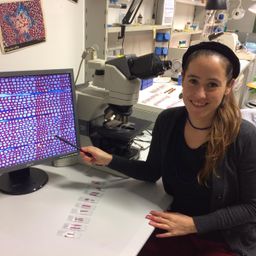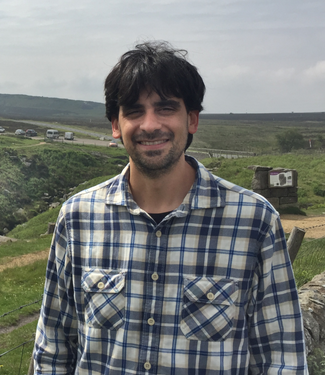
Paulina Fernanda Puchi Gonzalez
Sessions in which Paulina Fernanda Puchi Gonzalez participates
Tuesday 28 June, 2022
Improving our understanding of the carbon cycle is key to addressing the challenges of climate change. In this study, we investigated the relationships between intra and inter-annual climate variations, carbon fluxes, and the xylem biomass in an 80-year plantation of Pinus strobus at Turkey Point, Ontario, Canada. From eddy covariance tower, we obtained daily Gross Primary Production (GPP), precipitation and air temperature for the period 2003-2018. To determine inter-and intra-annual xyle...
Sessions in which Paulina Fernanda Puchi Gonzalez attends
Monday 27 June, 2022
MAIDENiso is a numerical process-based model that allows researchers to simulate the growth of a virtual tree. Using daily meteorological data, the model simulates the physical and physiological processes taking place in the tree and its environment, to produce daily and yearly outputs comparable to dendrological observations. The model has been adapted and used successfully in boreal regions in North America. In an inverse mode, tree-ring obs...
Wednesday 29 June, 2022
Current and projected changes in climate are estimated to be from 10 to 100 times faster than the natural adaptive capacity of trees whose generation times are long. As extreme climatic events are becoming more frequent and exert a strong selection pressure on tree populations, there is an urgent need to better characterize the genetic variability involved in the response of trees to climate. There is currently a lack of knowledge on the role of genetic variability in tolerance to climatic...
Information garnered from historical timbers and wooden artifacts (e.g. houses, barns, ships) can greatly enhance our understanding of human, ecological, and climate history, especially in regions where few old-growth forests and trees remain, tree longevity is relatively short (less than 300-400 years), and environmental conditions break down wood rather quickly, like in mesic to wet regions Over the last decade plus, the application of tree-ring techniques on woo...
Session reescheduled from June 28th to June 29th
Rescheduled from June 28th to June 29th
This is a mandatory (!) .... and FREE (!!) cocktail & award ceremony (!!!)(in replacement of the Banquet formula)->->->->->->->->->->->->->->->->->->After a great summer day of scientific and urban discoveries in our beloved MTL, we wish to bring together all the AmeriDendro community in one place and congratulate the TRS awardees for their remarkable achievements! -Bonsinsegna award-Fr...
Thursday 30 June, 2022
How old are tropical trees? This fundamental question has long driven the curiosity of laymen and scientists. But only recently, a great number of studies conducted by many brave dendrochronologists resulted in a significant tree-ring-based knowledge that allows us to start accurately estimating tree ages across the globe. As science goes, not only knowing the longevity of tropical trees is essential to understanding forest dynamics and its role in biogeochemical cycles, but one must also ...
Dendrochronological archives in the tropics of the Americas have been under-studied for a long time. Some of the challenges include the Identification of tree-ring boundaries in certain tree species, absence of winter dormancy associated to low temperatures in most of the cases, and logistic difficulties of fieldwork in remote sites. However, part of the slow progress is also related to the fact that historically much less resources have been inv...
In their book chapter in 2011 Gagen et al. (2011) highlighted the need for stable isotope dendroclimatology to move beyond studies that simply demonstrate ‘potential’. This symposium, more than a decade since this publication, will focus on dendrogeochemical studies that demonstrate that the field has moved beyond studies focused on ‘potential’. In particular, this session will strive to identify compelling new insights into unique aspect...
A gap of millennial tree-ring data suitable for dendroclimatology has long been evident in the North American boreal forest. In my talk, I will describe the adaptive approach we have developed to build and improve a data network for millennial dendroclimatology in the eastern Canadian taiga. Recurrence of stand replacing wildfires is the most important constrain to the elaboration of long tree ring chronologies, which can only be developed away from regions ...
The interpretation of stable isotopes in a dendroecological framework can provide powerful insights into how trees adjust physiologically in response to the environment. This symposium aims to bring together researchers who use stable isotopes in tree rings to address ecophysiological responses to environmental changes from intra-annual to multi-decadal resolution. We hope this symposium will enable fruitful discussions and new ideas a...
Allies have emerged as key enablers of diversity and inclusivity initiatives in the workplace, in professional associations, and in everyday life. But what is an ally? What skills are required to be an effective ally? How do we hold ourselves and our community members accountable for being effective allies? This symposium will provide a deeper understanding of what it means to be an ally and the skills to help advance allyship as individuals and as a community. Fur...
(by bus, max 92 people)Designed for visitors and newcomers, the tour is based on the pleasure...


